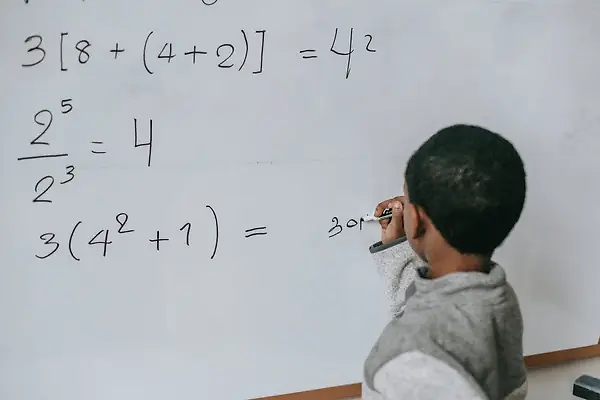Math is a subject that many kids tend to struggle with. It is not uncommon to see kids eventually lose interest in developing their numerical literacy, which can make coping with math increasingly difficult as they advance to middle and high school.
Math & ELA | PreK To Grade 5
Kids see fun.
You see real learning outcomes.
Watch your kids fall in love with math & reading through our scientifically designed curriculum.
Parents, try for free Teachers, use for free
It is critical to ensure that kids are equipped with the tools (or tricks!) to help them tackle math problems confidently and easily. But what kind of tools are we talking about, anyway? Math tricks can be helpful for kids in several ways. They can help them reduce the number of steps that they need to take to tackle a problem and arrive at the right solution.
They can also offer kids a range of ways to approach and solve the same problem. Getting a grasp of math tricks can ultimately make math more interesting and less daunting for kids. So why not give them a whirl? Here are some math tricks with answers and examples to help you catch on fast.
Let’s get started!
Mental Math Tricks for Kids to Try Out

1. Multiplying Large Numbers in Your Head
The ability to multiply large numbers is a basic component of math for kids in both middle and high school. Multiplying large numbers mentally without any external aid can help kids improve both their speed and their ability to tackle multiplication questions.
A great way to multiply two double-digit numbers is by multiplying their distance from 100 to simplify the math. Let’s discuss the steps. We will find 95 × 97 using this trick.
Step 1: Subtract each number from 100.
100 − 95 = 5 and 100 − 97 = 3
Step 2: Add resulting values (5 and 3) together.
Sum = 5 + 3 = 8
Step 3: Subtract this sum from 100, giving us the answer’s first part.
First part of the answer = 100 − 8 = 92
Step 4: The second part of the answer can be obtained by multiplying 5 and 3! Voilà!
Second part of the answer = 5 × 3 = 15
So, 95 × 97 = 9215
2. Adding Large Numbers
When it comes to math, it’s easy to forget that addition and subtraction can be just as challenging as multiplication and division for some kids. They can then employ a few tricks to make adding numbers mentally fun and simple.
One of the simpler ones involves using place value systems. Let’s add 81 and 45 using this trick.
Break the numbers down using the place values (known as the expanded form of numbers).
81 = 80 + 1
45 = 40 + 5
Add the tens together and add the digits at ones place to this sum. That’s all there is to it!
80 + 40 = 120
5 + 1 = 6
So, 81 + 45 = 120 + 6 = 126
3. Multiplying a Number by 6
You never know when you’ll need to multiply a number by 6. Luckily, there is a trick to ensure you can do it quickly and with little effort!
When you multiply an even number by 6, the resulting value will always end with the same digit you multiplied 6 by. We will only find the digit at the tens place.
Consider 6 x 8. The product will end with 8. Let’s find the tens place.
Divide the value that you seek to multiply with 6 by 2. In this case, we will divide 8 by 2.
8 ÷ 2 = 4
Take the resulting value, which is 4 here, and place it before the number you are multiplying 6 with. In other words, place 4 before 8, and you have 48!
4. Multiplying a Number by 9
Multiplying any number by 9 is easier than you could ever imagine! Take any large value. Let’s go with 873! Understand how this trick works.
873 × 9 = 873 × (10 − 1) = 8730 – 873 = 7857
All you have to do is multiply this large number by 10, giving you 8730. Now, you have to subtract 873 from this product. The resulting value, 7857, is the answer, and it’s exactly what you would get by multiplying 9 with 873!
Take a look at two more examples.
586 × 9 = 586 × (10 − 1) = 5860 − 586 = 5274
211 × 9 = 211 × (10 − 1) = 2110 − 211 = 1899
Vedic Math Tricks Kids Won’t Believe

1. Addition
A Vedic Math trick for simplifying addition involves focusing on the closest multiple of 10 for each number involved to make the process a breeze. Let’s add 28 and 97 as an example.
How would you go about adding these large double-digit numbers? This Vedic trick would have you find out and add their closest multiples of 10.
Step 1: Multiple of 10 closest to 28 is 30. Multiple of 10 closest to 97 is 100.
Adding them would give us 100 + 30 = 130.
Step 2: Subtract original numbers from their closest multiples of 10.
30 − 28 = 2 and 100 – 97 = 3
The sum of 2 and 3 is 5. Subtract 5 from 130.
130 − 5 = 125, which is your answer! Can’t get easier than that!
Related Reading: How to Make Adding and Subtracting Fractions Easy
2. Subtracting any Number from 1000, 10,000, or 100,000
Subtracting a number from powers of 10 such as 1000, 10000, or 100000 gets easy with this Vedic Math trick! This is an easy trick that involves just a few mental steps. Here, the number of zeros should match the number of digits in the number we are subtracting.
Let’s take 432 as our example! Subtract all the digits except the ones digit from 9 and subtract the ones digit from 10. If you had to subtract 432 from 1000 (3 zeros and 3 digits are matching), subtract the first two digits of 432 from 9 (9 − 4 = 5 and 9 − 3 = 6) and subtract the last digit of 432 from 10 (10 − 2 = 8).
This gives us 5, 6, and 8; your answer is 568!
Consider another example. If the number of digits does not match, add zeros before the number.
10,000 − 754 = 10,000 − 0754 = 9246
Try subtracting 568 from 10,000 and 8374 from 100,000 to see how well you understand this simple trick!
3. Square Roots
Although not a trick per se, Vedic math provides several helpful pointers that can guide you when trying to identify a number’s square root. First and foremost, we must understand that numbers ending with 2, 3, 7, and 8 are not perfect squares.
This means that whenever you see a number that ends with the digit 2, 3, 7, or 8, it is safe to conclude that the number will not have a perfect square root (or a whole number as a square root). If a perfect square ends with 1, such as 121 or 81, its square root will always end with 1 or 9. A perfect square that ends with 4, such as 4 or 64, will always have a square root that ends with 2 or 8!
4. Squares
A Vedic math trick makes identifying the square value of numbers very straightforward! Let’s take 98, for example. How would you go about finding the square of 98? Your base here will be 100.
Find the difference of the number from the base. In other words, we would have to subtract 100 from 98.
100 − 98 = 2.
Subtract 2 from our original number, which in this example is 98.
98 − 2 = 96
Multiply this number by the base.
96 x 100 = 9800.
The last thing you have to do is add the square value of 2, which is 4 to 9800.
9800 + 4 = 9804 becomes our answer!
Math Number Tricks for Kids to Learn

1. Birthday Math Trick
If you’re looking for a fun birthday math trick that can also help you improve your numeric literacy, then we have just the idea for you! This one takes a few steps to work, so you might want to sit and grab a calculator.
Step 1: Add 18 to the number of your birthday month. January, for instance, would be 1 in this case, and May would be 5.
Step 2: Multiply the resulting value by 25, and follow that by subtracting 333!
Step 3: Multiply the new value by 8, and follow that by subtracting 554!
Step 4: Divide the new value by 2, and add your date of birth.
Step 5: Multiply the new value by 5 and add 692 to the new value.
Step 6: Multiply the new value by 20, and add the last two digits of your birth year.
Step 7: Subtract the number 32940 from the latest value, and look at the number you get!
No matter who you try this trick on, the answer will always give us a person’s date of birth in the format of DD-MM-YY! Don’t take our word for it! Give it a go yourself!
2. The 1089 Trick
Here’s another trick you can try on someone that will amaze them! If you do it correctly, you will always arrive at 1089!
To start off, ask someone to write down any three-digit number. Ask them to rearrange the units of the three-digit numbers written in ascending and descending order.
If the number they wrote down is 603, then the descending order of the number would be 036, while the ascending order would be 630. After this, ask the person to subtract the descending arrangement from the ascending arrangement.
The number they should have now is 594. Ask them to reverse this value and add it to 594. In other words, 594 + 495 is what the next step should look like.
No matter which three-digit number the person chooses, the answer will always be 1089! Try it out for yourself!
3. The 37 Trick
If you’re looking to impress your friends and family with a cool math problem that always results in a value of 37, then you’re in luck! All you have to do is select any three-digit number with the same digits.
Let’s take 666, for example. All you need to do is add the three digits together. In this case, 6 + 6 + 6 gives us 18. After this, divide 666 by 18. Any guesses? That’s right! 37.
This simple trick works on any three-digit number with the same three units! Have fun impressing your friends and family with this trick!
4. The 15 Trick
For our last trick, we will discuss another trick that gives you the same value no matter what number you start with! In this one, the answer will always be 15.
Start by asking a friend to pick a number. Ask them to multiply that number by 3. After that, ask them to add 45 to the resulting value. Once they have done that, ask them to multiply the answer by 6 and then divide it by 18.
For the last step, ask them to subtract the number they picked at the very beginning from the newest value. No matter what number they started with, the answer will always be 15!
To top this trick off, you can pretend to read your friend’s mind and tell them the answer is 15 once they have completed all these steps! Such math mind tricks are sure to impress!
Related Reading: Best Math Apps for Students
Easy Math Tricks for Kids to Enjoy

1. Adding Double-digit Numbers Together
There is a really fast way to add double-digit numbers! For this trick, let’s take 56 and 79.
We will start by splitting the second number into tens and units. That gives us 70 and 9! Let’s follow this up by adding 70 to 56, which gives us 126. All we’re left to do from here is to add 9 to 126, giving us our answer, 135!
Splitting numbers into tens and units can be a lightning-fast approach to adding double-digit numbers and a trick worth keeping up your sleeve!
2. Multiplying Numbers by 15
You never know when you might have to multiply a number by 15! Let’s take 69 as an example.
All you have to do first is add a 0 at the end of 69. You then have to divide the resulting value, 690, by 2, giving you 345.
All you have to do for your final step is add 690 to 345, which gives us 1035! And there you have it!
How does it work? Understand that multiplying by 5 is equivalent to multiplying by 10 and then dividing by 2.
69 x 15 = 69 x (10 + 5) = 690 + (69 x 5) = 690 + 345
Math doesn’t need to be a daunting subject that scares off students. Even the most difficult problems can be tackled mentally with a few tricks! Mastering these tricks can induce confidence in students and improve their numeric literacy!
3. Multiplying a Two-digit Number by 11
You may not have to multiply a two-digit number by 11 often, but in case you do, this trick should help you save time! Let’s take 32, for example. How would you quickly multiply 32 by 11?
You have to start by figuring out the sum of 3 and 2, which gives us 5. Simple enough so far? You must then place the sum of these digits, 5, between 3 and 2. That would give us 352. Let’s try it again with another number. Let’s take 51 this time.
What do we get when we add 5 and 1? 6! All we need to do from now on is place 6 between 5 and 1, to give us 561!
However, there is one thing to remember about this trick. What to do if the additive value of the digits is double-digit? Consider 67 x 11.
6 + 7 = 13
Place it between the digits and add the tens digit of 13, which is 1. Thus, we’ll 1 to 6;
6(13)7 = (6+1)(3)7 = 737 A bit of practice with these tricks can help make math more fun, rewarding, and less daunting for students willing to make an effort to master them!
Frequently Asked Questions (FAQs)
Which math tricks should children start learning first?
Some tricks are definitely more challenging to grasp than others. However, whether a student finds it more difficult to multiply numbers by 11 in their head or figure out the squares of smaller numbers depends completely on them!
What order or hierarchy should I follow to teach my kids mental math formulas and tricks?
There’s no need to follow a particular order, and it’s best to allow a child to go through these independently. Let them decide which is more interesting to start learning immediately and which ones they’d like to reserve for another day!
When can a student start learning these tricks?
This depends completely on the student and their learning abilities! We expect some of these tricks to be more accessible even to elementary school students with an affinity for math, while some students might find themselves better equipped to grasp them in middle school. There is no correct time for a student to start, and it’s probably best to make fun math magic tricks accessible at an early age and let them start when they can comfortably follow and use these tricks to aid their learning!
























